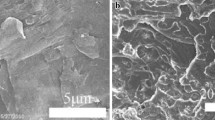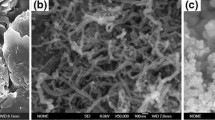Abstract
Polymer composites with improved thermal and flame-retardant performance are imperative for fire-safe materials. Carbon-based nanomaterials have the advantages of low cytotoxicity, chemical inertness, cost-effectiveness, and biocompatibility. Graphene quantum dots (GQDs) as a new member of carbon-based nanomaterials were fabricated by pyrolysis method, and easy to be functionalized to fabricate nanocomposites as efficient flame retardant. Herein, polystyrene (PS) nanocomposites with introduction of modified graphene quantum dots (C-GQDs) were fabricated by the Pickering emulsion polymerization method. The C-GQDs with controllable chemical structure could be used as stabilizer in emulsion polymerization system and introduced to PS directly. Morphological and chemical characterization of PS nanocomposites revealed that the successful introduction of C-GQDs to PS, and C-GQDs were wrapped on the surface of PS microspheres. The flammability behavior of the PS nanocomposites was investigated by using microscale combustion calorimeters (MCC), and the peak heat release rate of PS nanocomposite was reduced 40% when compared with that of neat PS. The improved flame retardancy was mainly attributed to the C-GQDs promoting the formation of physical protective barrier on the surface, which impeded the permeation of heat and the pyrolysis products. Therefore, a facile method for preparing nanocomposite has been developed in this work, and C-GQDs could be used as flame retardants to reduce the flammability of polystyrene nanocomposites system.
Graphical abstract






Similar content being viewed by others
References
Wang Y, Meng X, Wang C, Han Z, Shi H. Fire reaction properties of polystyrene-based composites using hollow silica as synergistic agent. J Therm Anal Calorim. 2020;8:1–8.
Chen X, Jiang Y, Jiao C. Smoke suppression properties of ferrite yellow on flame retardant thermoplastic polyurethane based on ammonium polyphosphate. J Hazard Mater. 2014;266:114–21.
Zhou K, Wang B, Jiang S, Yuan H, Song L, Hu Y. Facile preparation of nickel phosphide (Ni12P5) and synergistic effect with intumescent flame retardants in ethylene–vinyl acetate copolymer. Ind Eng Chem Res. 2013;52:6303–10.
Chen X, Wei S, Gunesoglu C, Zhu J, Southworth CS, Sun L, Karki AB, Young DP, Guo Z. Electrospun magnetic fibrillar polystyrene nanocomposites reinforced with nickel nanoparticles. Macromol Chem Phys. 2010;211:1775–83.
Brannum DJ, Price EJ, Villamil D, Kozawa S, Brannum M, Berry C, Semco R, Wnek GE. Flame-retardant polyurethane foams: one-pot, bioinspired silica nanoparticle coating. ACS Appl Polym Mater. 2019;1:2015–22.
Wang Z, Liu Y, Li J. Regulating effects of nitrogenous bases on the char structure and flame retardancy of polypropylene/intumescent flame retardant composites. ACS Sustain Chem Eng. 2017;5:2375–83.
Chen MJ, Lazar S, Kolibaba TJ, Shen R, Quan Y, Wang Q, Chiang H-C, Palen B, Grunlan JC. Environmentally benign and self-extinguishing multilayer nanocoating for protection of flammable foam. ACS Appl Mater Interfaces. 2020;12:49130–7.
Li Z, Liu L, Jiménez González A, Wang DY. Bioinspired polydopamine-induced assembly of ultrafine Fe(OH)3 nanoparticles on halloysite toward highly efficient fire retardancy of epoxy resin via an action of interfacial catalysis. Polym Chem. 2017;8:3926–36.
Ahmed L, Zhang B, Shen R, Agnew RJ, Park H, Cheng Z, Mannan MS, Wang Q. Fire reaction properties of polystyrene-based nanocomposites using nanosilica and nanoclay as additives in cone calorimeter test. J Therm Anal Calorim. 2018;132:1853–65.
Qin P, Yi D, Xing J, Zhou M, Hao J. Study on flame retardancy of ammonium polyphosphate/montmorillonite nanocompound coated cellulose paper and its application as surface flame retarded treatment for polypropylene. J Therm Anal Calorim. 2021;1:1–11.
Zhou K, Zhang Q, Liu J, Wang B, Jiang S, Shi Y, Hu Y, Gui Z. Synergetic effect of ferrocene and MoS2 in polystyrene composites with enhanced thermal stability, flame retardant and smoke suppression properties. RSC Adv. 2014;4:13205–14.
Chen Y, Li J, Lai X, Li H, Zeng X. N-alkoxyamine-containing macromolecular intumescent flame-retardant-decorated zrp nanosheet and their synergism in flame-retarding polypropylene. Polym Adv. Technol. 2021; 1–13.
Nyambo C, Songtipya P, Manias E, Jimenez-Gasco MM, Wilkie CA. Effect of MgAl-layered double hydroxide exchanged with linear alkyl carboxylates on fire-retardancy of PMMA and PS. J Mater Chem. 2008;18:4827–38.
Huang SC, Deng C, Chen H, Li YM, Zhao ZY, Wang SX, Wang YZ. Novel ultrathin layered double hydroxide nanosheets with in situ formed oxidized phosphorus as anions for simultaneous fire resistance and mechanical enhancement of thermoplastic polyurethane. ACS Appl Polym Mater. 2019;1:1979–90.
Ning H, Ma Z, Zhang Z, Zhang D, Wang Y. Core-shell expandable graphite @ layered double hydroxide as a flame retardant for polyvinyl alcohol. J Therm Anal Calorim. 2021;7:1–10.
Attia NF, Saleh BK. Novel synthesis of renewable and green flame-retardant, antibacterial and reinforcement material for styrene–butadiene rubber nanocomposites. J Therm Anal Calorim. 2020;139:1817–27.
Wang X, Kalali EN, Wan JT, Wang DY. Carbon-family materials for flame retardant polymeric materials. Prog Polym Sci. 2017;69:22–46.
Attia NF, Sally EA, Elashery AM, Abdelazeem SE, Hyunchul O. Recent advances in graphene sheets as new generation of flame retardant materials. Mater Sci Eng B. 2021;274:115460.
Attia N F. Sustainable and efficient flame retardant materials for achieving high fire safety for polystyrene composites. J Therm Anal Calorim. 2021: 1–10.
Han Y, Wu Y, Shen M, Huang X, Zhu J, Zhang X. Preparation and properties of polystyrene nanocomposites with graphite oxide and graphene as flame retardants. J Mater Sci. 2013;48:4214–22.
Attia NF, Abd El-Aal NS, Hassan MA. Facile synthesis of graphene sheets decorated nanoparticles and flammability of their polymer nanocomposites. Polym Degrad Stab. 2016;126:65–74.
Xing W, Yang W, Yang W, Hu Q, Si J, Lu H, Yang B, Song L, Hu Y, Yuen RKK. Functionalized carbon nanotubes with phosphorus- and nitrogen-containing agents: effective reinforcer for thermal, mechanical, and flame-retardant properties of polystyrene nanocomposites. ACS Appl Mater Interfaces. 2016;8:26266–74.
Khose RV, Pethsangave DA, Wadekar PH, Ray AK, Some S. Novel approach towards the synthesis of carbon-based transparent highly effective flame retardant. Carbon. 2018;139:205–9.
Rahimi-Aghdam T, Shariatinia Z, Hakkarainen M, Haddadi-Asl V. Nitrogen and phosphorous doped graphene quantum dots: excellent flame retardants and smoke suppressants for polyacrylonitrile nanocomposites. J Hazard Mater. 2020;381:121013.
Ma R, Zeng M, Huang D, Wang J, Cheng Z, Wang Q. Amphiphilicity-adaptable graphene quantum dots to stabilize ph-responsive pickering emulsions at a very low concentration. J Colloid Interface Sci. 2021;601:106–13.
Yin G, Zheng Z, Wang H, Du Q, Zhang H. Preparation of graphene oxide coated polystyrene microspheres by pickering emulsion polymerization. J Colloid Interface Sci. 2013;394:192–8.
Liu Y, Zhang Y, Duan L, Zhang W, Su M, Sun Z, He P. Polystyrene/graphene oxide nanocomposites synthesized via pickering polymerization. Prog Org Coat. 2016;99:23–31.
Xu Q, Mensah RA, Jin C, Jiang L. A critical review of the methods and applications of microscale combustion calorimetry for material flammability assessment. J Therm Anal Calorim. 2021;7:1–13.
Jung R, Park WI, Kwon SM, Kim HS, Jin HJ. Location-selective incorporation of multiwalled carbon nanotubes in polycarbonate microspheres. Polymer. 2008;49:2071–6.
Maity N, Kuila A, Das S, Mandal D, Shit A, Nandi AK. Optoelectronic and photovoltaic properties of graphene quantum dot–polyaniline nanostructures. J Mater Chem A. 2015;3:20736–48.
Shi Y, Liu C, Liu L, Fu L, Yu B, Lv Y, Yang F, Song P. Strengthening, toughing and thermally stable ultra-thin MXene nanosheets/polypropylene nanocomposites via nanoconfinement. Chem Eng J. 2019;378:122267.
Lu H, Wilkie CA. Fire performance of flame retardant polypropylene and polystyrene composites screened with microscale combustion calorimetry. Polym Adv Technol. 2011;22:14–21.
Lu H, Wilkie CA, Ding M, Song L. Flammability performance of poly(vinyl alcohol) nanocomposites with zirconium phosphate and layered silicates. Polym Degrad Stab. 2011;96:1219–24.
Xu Q, Jin C, Majlingova A, Restas A. Discuss the heat release capacity of polymer derived from microscale combustion calorimeter. J Therm Anal Calorim. 2018;133:649–57.
Acknowledgements
The authors acknowledge the use of the Materials Characterization Facility (MCF) at Texas A&M University for SEM. The authors also thank Dr. Hung-Jue Sue for using TGA instrument.
Author information
Authors and Affiliations
Corresponding author
Ethics declarations
Conflict of interest
The authors declare that they have no conflict of interest.
Additional information
Publisher's Note
Springer Nature remains neutral with regard to jurisdictional claims in published maps and institutional affiliations.
Supplementary Information
Below is the link to the electronic supplementary material.
Rights and permissions
About this article
Cite this article
Ma, R., Shen, R., Quan, Y. et al. Tunable flammability studies of graphene quantum dots-based polystyrene nanocomposites using microscale combustion calorimeter. J Therm Anal Calorim 147, 10383–10390 (2022). https://doi.org/10.1007/s10973-022-11277-9
Received:
Accepted:
Published:
Issue Date:
DOI: https://doi.org/10.1007/s10973-022-11277-9




